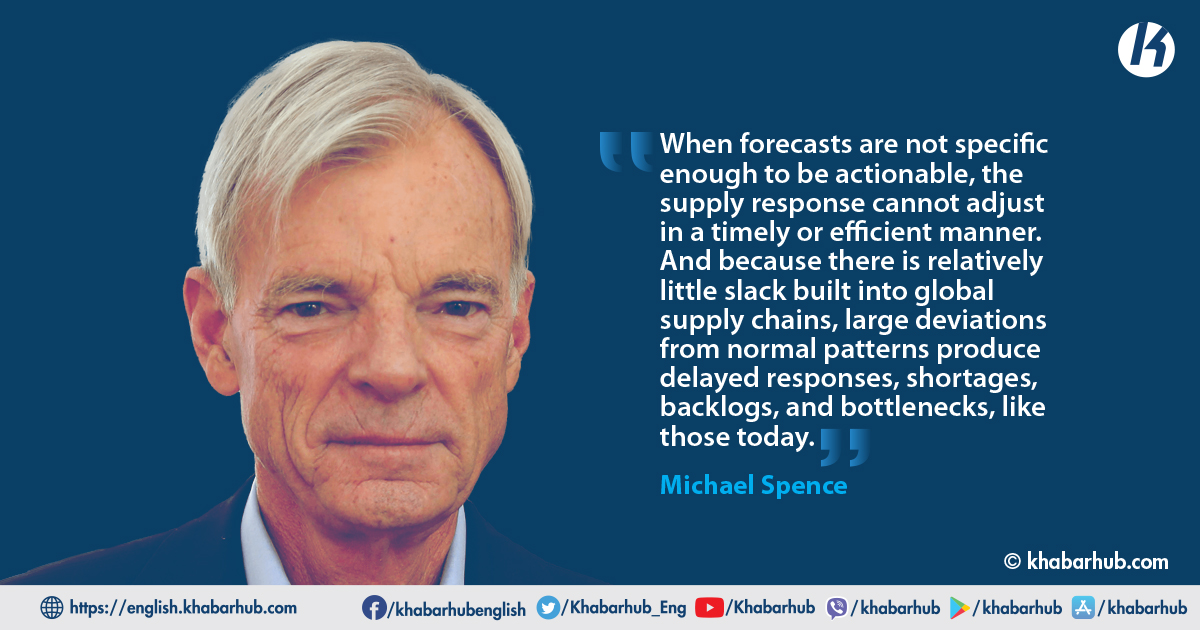Supply-chain disruptions are severely hampering the global economic recovery. It is a strange situation in many ways.
The types of products and services affected by delays and shortages – including a wide range of intermediate goods, from commodities to semiconductors, and the final products that depend on them – resemble what one would see in a wartime economy. And the disruptions took us largely by surprise.
In fact, in the first quarter of this year, growth was overwhelmingly projected to accelerate, and experts were not exactly sounding the alarm that supply would fail to keep up.
Yes, influential macroeconomists did warn that the combination of highly accommodative monetary policy, elevated household-savings balances, pent-up demand, and massive fiscal spending significantly increased the risk of inflation.
And, yes, those forecasts – which appear increasingly prescient – implied that a surge in aggregate demand, fueled by a wall of liquidity and frothy asset prices, could outpace supply.
But the likely duration of the imbalance remained unknown, and many argued that inflation – and, by extension, supply disruptions – would be “transitory.”
Many observers remain convinced that this is the case. But participants in global supply chains increasingly predict that the shortages, backlogs, and imbalances between supply and demand will persist well into 2022, and perhaps longer.
Global supply networks are similarly complex. But, while we might be able to anticipate broad trends – such as that demand will increase – there is no model or set of models that enable us to predict with any precision how such trends might affect specific elements in supply chains.
It seems clear that, for some significant period, global economic growth will be constrained by supply – a sharp contrast from the years after the 2008 global financial crisis.
Although the surge in demand may be larger than mid-pandemic forecasts indicated, it was the basis for the high growth projections in the pandemic recovery period.
That makes it all the more important to address two fundamental supply-side questions. First, are there underlying supply constraints that will persist even after pandemic-related blockages are cleared?
And, second, is there something about the configuration and functioning of global supply chains that affects the supply response?
One can reasonably make the case that the pandemic produced semi-permanent changes in some supply factors. For starters, many workers have dropped out of the labor market or deferred reentering it, despite the rollback of pandemic-support mechanisms.
This probably has much to do with the highly stressful or dangerous conditions under which some, such as health-care personnel, worked during the pandemic. Many cargo workers were stranded on ships for months.
If workers are to accept such positions now, they will probably demand better compensation and changes in working conditions.
Likewise, many of those who shifted to working remotely during the pandemic are resisting a full-time return to the office.
Such shifting demands and preferences imply supply-side changes in many segments of the labor market, with unknown long-run effects.
But labor-supply effects are only part of the story. We knew that a surge in demand was coming. So, why were global supply chains caught flat-footed?
One reason is that pent-up demand was unleashed before the pandemic was actually over. So, as demand increased, pandemic-related disruptions continued to affect major ports and manufacturing facilities, dampening the supply response.
Another factor is that demand seems to have risen beyond the system’s peak load capacity. Expanding that capacity will require investment and, more important, time.
But, while peak load capacity is crucial in services like electricity (which is difficult to store), it is less important for goods, demand for which must be managed with a well-functioning system that anticipates surges and spreads out the order flow.
Therein lies the problem. Global supply networks, as they are currently constituted, are complex, decentralized, and wound tightly, in order to maximize efficiency and minimize waste.
But, while this approach works in normal times, it cannot handle major shocks or perturbations. Decentralization, in particular, leads to underinvestment in resilience, because the private returns on such investments are much smaller than the system-wide returns or benefits.
Another consequence of decentralization is subtler, and perhaps most easily explained with an analogy to weather forecasting.
Although weather is the result of an incredibly complex and interconnected system, forecasting has become increasingly precise and accurate over time, thanks to highly sophisticated models that capture the way relevant factors – such as wind, atmospheric and ocean temperatures, and cloud formation – interact.
The costs of a hurricane or tsunami are greatly reduced when accurate forecasts enable people to plan ahead. Supply-chain disruptions are no different.
Global supply networks are similarly complex. But, while we might be able to anticipate broad trends – such as that demand will increase – there is no model or set of models that enable us to predict with any precision how such trends might affect specific elements in supply chains.
We have no way of knowing, for example, where new bottlenecks will occur, let alone how market participants should adjust their behavior.
When forecasts are not specific enough to be actionable, the system cannot adjust in a timely or efficient manner.
The system is essentially myopic: it discovers the blockages when they occur. And because there is relatively little slack built into it, large deviations from normal patterns produce delayed responses, shortages, backlogs, and bottlenecks, like those we are seeing today.
The conclusion is clear: We need better models for predicting how supply chains will evolve, including their likely responses to shocks.
These forecasts need to be publicly available so that all participants can see them and adapt. Artificial intelligence would likely be the key to success; indeed, this is a natural application of the technology. But international cooperation, with countries sharing real-time data generated by supply-chain networks, would also be needed.
The costs of a hurricane or tsunami are greatly reduced when accurate forecasts enable people to plan ahead. Supply-chain disruptions are no different.
(Michael Spence, a Nobel laureate in economics, is Professor of Economics Emeritus and a former dean of the Graduate School of Business at Stanford University)
Copyright: Project Syndicate









Comment